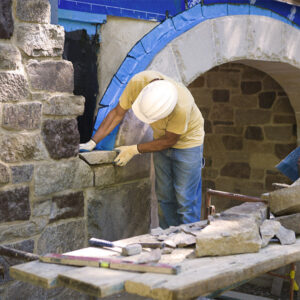How to Become a Stone Mason
The demand for skilled stonemasons is expected to grow dramatically over the next few years, with increasing populations and expanding economies stimulating a booming construction industry. A high school diploma is not necessary to become a stone mason. However, those interested in this career path may consider furthering their education by attending a college of applied science or technology. The most common educational programs last for three years and are offered by private businesses and unions. Apprentices typically spend three years on the job while also attending classes. Apprentices must be at least seventeen years old and in good health.
There are many aspects to a career as Stone Mason Charleston SC including attention to detail. Throughout their work, stonemasons must slow down and examine each structure carefully. They should also be able to read the material’s natural cracks and weaknesses. They should also be able to follow safety protocols and look out for each other. While it may not seem necessary to acquire additional training, a good foundation in mathematics is essential.
A stone mason is a skilled worker who uses manual skills to fit stonework into place on a building project. They can be either a banker mason (in a workshop) or a fixer mason (on-site). These work in similar ways, but they do have different requirements.
Some stone masons work for several buildings. In addition to working on buildings, they also perform repointing, which is the process of replacing deteriorated mortar. This is a necessary part of maintaining stonework, as it can increase a property’s aesthetic value. Vandalism and graffiti are major problems in urban areas, so stone masons often provide graffiti removal services as well.
Additional training is a great way to boost your stonemason credentials and demonstrate your expertise to potential employers. Some colleges and trade associations offer masonry training courses. You can also get training at community colleges. Some colleges offer one-year courses, while others offer specialized certifications for brick masons. In addition to becoming a stonemason, you can further your career by obtaining a CSCS card. You can start your education with a Level 1 Certificate in Construction Skills and a Level 2 Diploma in Stonemasonry.
Tools are another essential part of a stonemason’s arsenal. Basic stone shaping tools include chisels, mallets, and a straight metal edge. These tools come in different sizes, shapes, and materials. Different tools are used for different materials, and some are even renamed based on the area where they are used.
Tools used by stonemasons can include a masonry trowel, lewis, and a walling hammer. These tools can be used for pointing in the joints and filling gaps in the stonework. There are also tools for setting building stones, such as tuck pointers and margin trowels.
Another type of stone mason is a fixer or banker mason. These masons travel to various jobs and work the stone into the desired shape. They may work with heavy pieces of rock or even at high elevations. Some masons even use block and tackle systems to work with heavy stones. Some masons also specialize in carving and constructing memorials, such as gravestones. For many, their skills in these two different branches of the trade are essential to success in their line of work.
The duties of a stonemason include shaping and fitting stone to the exact measurements specified in a construction plan. They may also use hand tools, such as chisels and hammers, to create intricate details in the stone. In addition to installing and repairing buildings, stonemasons also repair damaged or chipped stones and use their expertise to maintain and restore structures and monuments.
A stone mason is responsible for shaping, fitting, and setting stones. Using their natural eye and a variety of hand tools, stone masons transform a pile of stone into an artistic piece of art. As a stone mason, you must have a keen eye for detail and a strong artistic vision. A stone mason must understand the whole structure of a stone, including its symmetry, size, and its contrasting colors.
Throughout history, stonemasons have been part of a guild structure. Members of the guild were ranked according to their knowledge and experience. Those who were new to the trade were called Apprentices and worked their way up to the rank of Journeyman. As journeymen, they were paid for the work they performed. The highest honor was Master Mason. This meant that a stonemason was trusted and able to travel freely.
